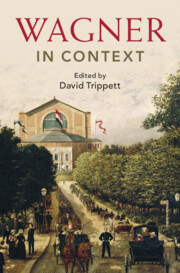76 results
Abbreviations
-
- Book:
- Wagner in Context
- Published online:
- 14 March 2024
- Print publication:
- 14 March 2024, pp xxiii-xxiv
-
- Chapter
- Export citation
Musical Examples
-
- Book:
- Wagner in Context
- Published online:
- 14 March 2024
- Print publication:
- 14 March 2024, pp x-x
-
- Chapter
- Export citation
Acknowledgements
-
- Book:
- Wagner in Context
- Published online:
- 14 March 2024
- Print publication:
- 14 March 2024, pp xxii-xxii
-
- Chapter
- Export citation
IV - Life, Language, and the Ancient World
-
- Book:
- Wagner in Context
- Published online:
- 14 March 2024
- Print publication:
- 14 March 2024, pp 227-284
-
- Chapter
- Export citation
VI - Reception
-
- Book:
- Wagner in Context
- Published online:
- 14 March 2024
- Print publication:
- 14 March 2024, pp 353-431
-
- Chapter
- Export citation
II - People
-
- Book:
- Wagner in Context
- Published online:
- 14 March 2024
- Print publication:
- 14 March 2024, pp 93-148
-
- Chapter
- Export citation
V - Music and Performance
-
- Book:
- Wagner in Context
- Published online:
- 14 March 2024
- Print publication:
- 14 March 2024, pp 285-352
-
- Chapter
- Export citation
Contributors
-
- Book:
- Wagner in Context
- Published online:
- 14 March 2024
- Print publication:
- 14 March 2024, pp xi-xxi
-
- Chapter
- Export citation
Contents
-
- Book:
- Wagner in Context
- Published online:
- 14 March 2024
- Print publication:
- 14 March 2024, pp v-viii
-
- Chapter
- Export citation
Further Reading
-
- Book:
- Wagner in Context
- Published online:
- 14 March 2024
- Print publication:
- 14 March 2024, pp 432-446
-
- Chapter
- Export citation
Select Bibliography
-
- Book:
- Wagner in Context
- Published online:
- 14 March 2024
- Print publication:
- 14 March 2024, pp 447-453
-
- Chapter
- Export citation
Copyright page
-
- Book:
- Wagner in Context
- Published online:
- 14 March 2024
- Print publication:
- 14 March 2024, pp iv-iv
-
- Chapter
- Export citation
III - Politics, Ideas, and Bodies
-
- Book:
- Wagner in Context
- Published online:
- 14 March 2024
- Print publication:
- 14 March 2024, pp 149-226
-
- Chapter
- Export citation

Wagner in Context
-
- Published online:
- 14 March 2024
- Print publication:
- 14 March 2024
Index
-
- Book:
- Wagner in Context
- Published online:
- 14 March 2024
- Print publication:
- 14 March 2024, pp 454-460
-
- Chapter
- Export citation
Illustrations
-
- Book:
- Wagner in Context
- Published online:
- 14 March 2024
- Print publication:
- 14 March 2024, pp ix-ix
-
- Chapter
- Export citation
Introduction
-
-
- Book:
- Wagner in Context
- Published online:
- 14 March 2024
- Print publication:
- 14 March 2024, pp 1-8
-
- Chapter
- Export citation
Chapter 21 - Sentient Bodies
- from III - Politics, Ideas, and Bodies
-
-
- Book:
- Wagner in Context
- Published online:
- 14 March 2024
- Print publication:
- 14 March 2024, pp 205-216
-
- Chapter
- Export citation
I - Place
-
- Book:
- Wagner in Context
- Published online:
- 14 March 2024
- Print publication:
- 14 March 2024, pp 9-92
-
- Chapter
- Export citation
Chapter 5 - Liszt and Wagner
- from Part I - People and Places
-
-
- Book:
- Liszt in Context
- Published online:
- 23 September 2021
- Print publication:
- 14 October 2021, pp 38-47
-
- Chapter
- Export citation



